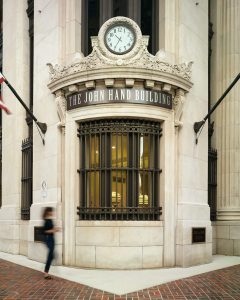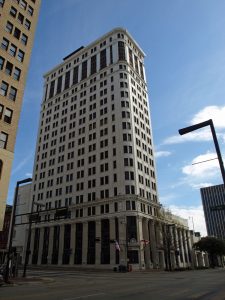The John A. Hand Building, located in Birmingham, Alabama, is an iconic historic structure that has become a symbol of the city’s rich architectural heritage. Standing tall at 17 stories, this neoclassical skyscraper has been a prominent feature of the Birmingham skyline since its completion in 1912. With its elegant design, grandeur, and historical significance, the John A. Hand Building continues to captivate visitors and serves as a reminder of Birmingham’s storied past.
Building Design
Designed by the architectural firm Miller, Martin & Lewis, the John A. Hand Building was named after its original owner, industrialist John A. Hand. At the time of its construction, it was considered one of the most innovative and modern buildings in the region. The building’s neoclassical design, featuring decorative brickwork, ornate cornices, and intricate detailing, showcases the architectural craftsmanship of the early 20th century.
One of the notable aspects of the John A. Hand Building is its grand entrance. The entrance features an impressive canopy supported by massive Doric columns, creating a sense of grandeur and prominence. The lobby further emphasizes the building’s elegance, with its marble floors, Corinthian columns, and intricate woodwork. The interior design reflects the opulence of the era and provides a glimpse into the building’s historic charm.
History
Over the years, the John A. Hand Building has served as a hub for various businesses and professionals. Originally built as an office building, it housed a range of tenants, including law firms, financial institutions, and medical practices. Its strategic location in the heart of downtown Birmingham made it a convenient and prestigious address for many esteemed businesses.
Despite its historical significance, the John A. Hand Building faced the threat of demolition in the latter part of the 20th century. However, due to a grassroots preservation effort, the building was saved from destruction. In 1983, it was listed on the National Register of Historic Places, ensuring its protection and recognition as a significant architectural landmark.
Today, the John A. Hand Building has been converted into mixed-use space that combines commercial and residential elements. It houses a variety of businesses, including law firms, creative agencies, and restaurants, which contribute to the vitality of the downtown area. The building’s upper floors have been transformed into residential lofts, offering residents a unique opportunity to live in a historic setting while enjoying the amenities and comforts of modern living.
The Significance of the John A. Hand Building
The preservation of the John A. Hand Building reflects the city’s commitment to honoring its architectural heritage and revitalizing its downtown core. The building stands as a testament to the resilience and adaptive reuse of historic structures, showcasing how an iconic landmark can be repurposed and integrated into a modern urban landscape.
Beyond its physical presence, the John A. Hand Building holds cultural and historical significance for the city of Birmingham. It serves as a reminder of the economic and industrial growth that Birmingham AL experienced during the early 20th century. The building represents a time of progress and prosperity in the city’s history, while also symbolizing the perseverance and determination of the community to preserve its heritage.
Furthermore, the restoration and preservation of the John A. Hand Building contribute to the overall revitalization of downtown Birmingham. The building’s historic charm and architectural beauty attract visitors and inspire further development in the surrounding area. Its presence enhances the appeal of the city center, fostering a vibrant and dynamic atmosphere that attracts residents, businesses, and tourists alike.
Summary
In conclusion, the John A. Hand Building stands as a shining example of historic preservation and adaptive reuse in Birmingham, Alabama. Its neoclassical design, intricate detailing, and rich history make it a beloved landmark in the city’s skyline. Through its adaptive transformation into mixed-use commercial and residential space, the building continues to contribute to the city’s growth and economic vitality. The John A. Hand Building is not only a physical structure but also a symbol of Birmingham’s past, present, and future, embodying the city’s commitment to preserving its architectural heritage and embracing its vibrant urban identity.
Another place of interest: City Federal





